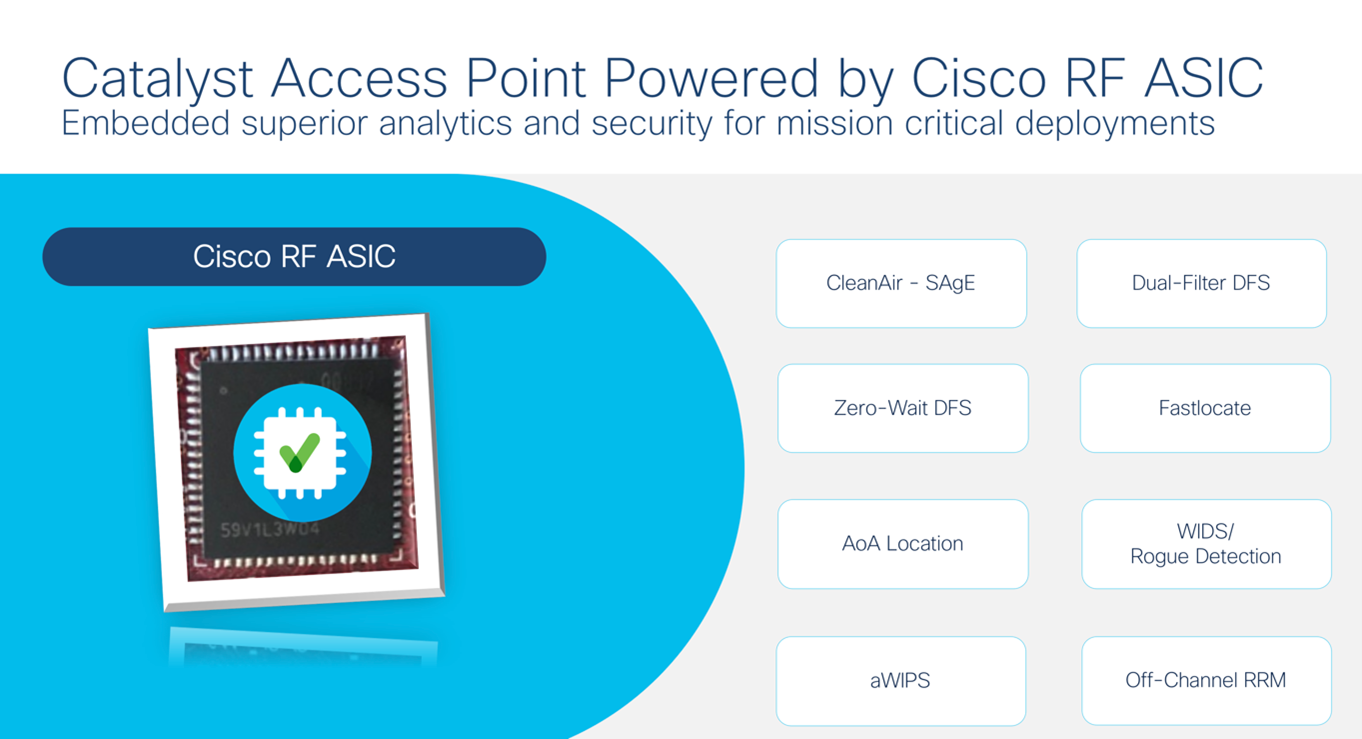Dedicated RF Engine offloads operations for higher performance and better analytics
You might have heard me screaming from the LinkedIn and Twitter mountaintops about how honored Cisco and the Cisco Wireless team are to have Cisco RF ASIC named the winner of the Best Enterprise Wi-Fi Network Technology Award by the WBA. However, in that moment, while I announced that Cisco won, I didn’t take the opportunity to explain why.
With that in mind I pulled together this post, so you can learn a little bit more about what makes the Cisco RF ASIC so special.

Why do you need the power of Cisco’s RF ASIC
Wireless, wireless, wireless…its all around us, it drives and enables us to more effectively communicate without being tied to a desk. As a result, more Wi-Fi access points are needed to support more wireless devices, introducing interference. Add to this, the explosion of IoT and you can see how adding more and more devices all clamoring for airtime, clogging up channels, and creating interference, can become an issue.
Because of this environment, Cisco has introduced the RF ASIC chipset on its Catalyst 9120 and 9130 Wi-Fi 6 access points. The RF ASIC helps organizations across industries tackle their IoT and Wi-Fi communication challenges by offloading advanced analytics capabilities and enhancing wireless communication.
The technology behind Cisco’s RF ASIC
The RF ASIC is an RF Unified Engine that improves the scanning efficiency of RF bands to provide efficient real-time analytics. The RF ASIC is made up of two 28nm chips: ASIC + RFIC; these chips analyze the range of frequencies by converting RF energy into I/Q data that is passed to the baseband processor. By working together, the RF ASIC engine is capable of very high-resolution scans and deep RF analysis.
This means that tasks such as identifying granular changes in the phase and amplitude of a signal or identifying and quantifying the modulation characteristics of the sampled signals are performed easily.

Cognitive radio technology seeks out and stops sources of interference in their tracks
Sources of RF interference come from more places than your neighboring Wi-Fi, although it’s a major contributing factor. As we see exponential growth in IoT device ecosystems that often share the same frequencies as our other Wi-Fi devices, developing and introducing always-on, dedicated off-channel radio scanning technology became imperative. This helps take advantage of Wi-Fi 6, ultra-low latency, and fair radio resource access in high density environments. Here’s how:
- CleanAir Spectrum Analysis handles the compute-intensive operations needed to identify sources of non Wi-Fi interference. RF ASIC hardware can track up to 16 simultaneous ongoing individual interference pulses and has a highly granular spectral resolution of 78.125 kHz. The RF ASIC offloads the processing of operations that are prohibitive in real-time software or by the client serving radios. The benefit is that the RF ASIC allows full multiband, real time CleanAir spectrum analysis, which previously could only be done by dedicating a client radio or with the addition of a Monitor Mode Access Point.
- Dual DFS Filter: The RF ASIC and CleanAir chipset augment the detection accuracy of radar signals as part of the Dynamic Frequency Selection (DFS) process. DFS functions drastically reduce the triggering of false positives and resulting disruption to clients by changing channels upon detection of a radar event. Dual DFS Filter eliminates 99.9% of false positive DFS hits. This capability improves accuracy in radar detection and preserves precious spectrum while improving the customer experience.
- Zero Wait DFS: DFS operations require a channel be monitored for 60 seconds before transmitting to ensure that there is no radar operating in the same frequency range. This process is called CAC (Channel Availability Check). The RF ASIC 5Ghz radio allows dedicated scanning independent of the client radios and can provide this service in the background. This allows the Access Point to pre-CAC all of the potential channels in the DFS range and immediately change (if needed) to and begin operating without delay.
- FastLocate: The Cisco DNA Spaces FastLocate feature improves location refresh rates by focusing on client data packets which are more consistent than probes. The RF ASIC operates in the background and requires no additional hardware or the sacrificing of an otherwise client serving resource.
- WIPS/WIDS (Rogue Detection and Mitigation): The RF ASIC radio detects rogue APs and clients by examining destAddr, srcAddr and inferring addresses from non-HT control frames. The RF ASIC allows continuous un-interrupted scanning in the background permitting full multiband analysis coverage while preserving the client experience.
- Off-Channel Radio Resource Management (RRM) Scanning and Neighbor Discovery Protocol (NDP) Transmission: RF ASIC performs off-channel scanning to analyze channel utilization. In typical RRM scenarios, when the radio is off channel, it cannot receive from or transmit to clients on the channel it was serving. In a busy network, this scanning is often interrupted periodically to prevent potential intermittent delays or packet loss on time sensitive applications. The RF ASIC radio offloads this function by continuously monitoring conditions and enhancing the performance of the access points’ client-serving radios.
The RF ASIC improves spectrum resolution with up to 25% more throughput and consistent latency for a better client experience.
Reliability & Quality of Experience
The RF-ASIC provides dedicated RF monitoring and analysis capabilities required to power Cisco’s most important features. The RF-ASIC enables these features for all, providing: security, performance, location context, and operational insights without compromise. All while dramatically increasing performance and improving the user quality of experience. It’s for these reasons that the Cisco RF ASIC technology was selected as the Best Wi-Fi Networking Technology of 2020 by the WBA.
Start your journey and learn more about the Cisco Catalyst 9100 Access Points.
Learn more about the WBA Industry Awards.
Check out our Intent-Based Networking video channel


CONNECT WITH US